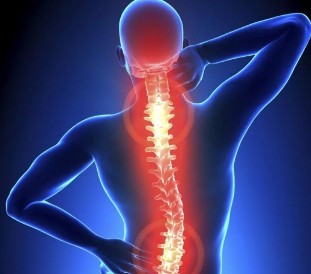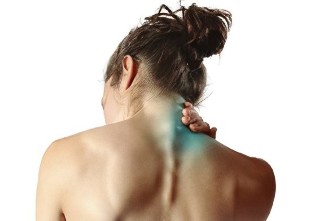Osteochondrosis of the cervical spine is a progressive disease that is a degenerative changes of the intervertebral discs, which is accompanied by their deformation and change of structure.

The causes of the disease. The main reason is the violation of metabolic processes in the body and as a result, the deterioration of blood supply of the intervertebral discs. Less frequently the disease occurs as a result of injury to the cervical spine. Contribute to the emergence of degenerative disc disease: sedentary lifestyle, incorrect posture, prolonged "sitting" at a Desk in front of the computer, etc.
Osteochondrosis of the cervical spine, the treatment at the clinic
Treatment of cervical degenerative disc disease the clinic conducts the methods of the Eastern medicine. In the process of treatment methods are used Tibetan medicine – point massage and herbal medicine methods of Chinese medicine is, first and foremost, acupuncture and moxibustion. It is possible to use a soft manual therapy, osteopathy (in t.. h "cranio-sacral techniques", which are a method of soft effects on bone and soft structures of the skull; the purpose of the method - the restoration of proper circulation of cerebrospinal fluid) and other methods available to the doctors clinic.

Treatment of degenerative disc disease of the cervical the spine is one of the basic directions of activity of the clinic. Based big experience of work in this direction, we can say that the results the treatment of this disease (including complicated protrusions and hernias of the spine) is quite satisfactory. Treatment of cervical degenerative disc disease is selected for each patient individually and is complex (in the process of conducting a session usually involves several methods of treatment, the duration of the session – 1-1,5 hours). Pain in the cervical spine, usually, removed up to 70% after 2-3 medical session. Treatment of osteochondrosis in average, from 5 to 11 sessions. In the course of treatment produced effects on the pathological changes in the body, which led to the emergence of the disease.
Features of osteochondrosis of the cervical spine
Cervical osteochondrosis, in comparison with thoracic and lumbar osteochondrosis has a number of features. These characteristics are determined, the main way, characteristics of the structure of the cervical vertebrae, the size of bone structures which is much smaller than the vertebrae of other departments. Cervical - the a movable spine, holding the head, it is constantly loaded. Osteochondrosis often affects the most mobile segments (roots-5 - S-7) - this determines the end the symptoms of degenerative disc disease of the cervical.
In the neck in a relatively small volume there are numerous vascular and nervous structures, in t.. h. here is vertebral artery, which supplies blood to the rear sections of the brain the medulla oblongata and the cerebellum. Upon compression of the vertebral artery due to the reduction circulation in the result of stenosis may develop ischemia of the brain and spinal cord, as in acute cases it can lead to stroke spinae. Symptoms of vertebral artery - dizziness, impaired coordination movements, deterioration of hearing and vision.
Due to the compactness of the cervical small the displacement of the vertebrae or muscle tension can cause nerve compression endings (a pinched nerve in the cervical spine) or vascular structures. The resulting eventually osteophytes in terms of compactness of the cervical aggravate the situation.

Cervical osteochondrosis leads to the formation of the protrusion and hernia of the spine, which (in addition to the above reasons, muscle tension, cervical dislocation, the formation of osteophytes), comprimarea nerve root, it cause swelling and inflammation. In the end, given the small size of the vertebral canal the cervical spine is the entire volume, additional compremised (compression occurs in the spinal canal). Clinical symptoms of this condition - severe pain.
Osteochondrosis can cause compression of the spinal cord, and because of the narrowness of the cervical spinal canal the spine is more common than in the thoracic and lumbar spine. In this case in the affected area does not just neck and head but also the top (which is more often) and lower limbs. It is in the nature of cervical osteochondrosis often (compared to lumbar and thoracic), leads the patient to disability.
Summing up, here are the factors that determine the compression of the different vascular and nervous structures in cervical osteochondrosis
- Displacement (slippage) of vertebral disc spondylolisthesis. The most common displacement is minimal, because even a small offset vertebrae in the cervical spine causes paralysis, and is often the cause of death outcome.
- Protrusions and hernias spine as a result of development of osteochondrosis of the cervical to spine and inside the spinal canal.
- Osteophytes. As the result of cervical degenerative disc disease at the sides of the vertebral bodies and the joints formed bony growths - osteophytes. Osteophytes located on the sides of the vertebral bodies adjacent to annoy him muscle, tone which increases. This increases the load on the vertebrae, leading to increased pressure on intervertebral disk height decreases, increases the risk of protrusion of the intervertebral disc. Osteophytes, aimed in the direction of the channel, where the vertebral artery may cause its stenosis.
- Reducing the height of the vertebral disc (the flattening of the intervertebral disc)is often caused by the compression of nerve roots by reducing the intervertebral foramen. In addition, in this case, if the unsuccessful turn neck possible subluxation of the cervical vertebrae, resulting in additional compression.

Cervical degenerative disc disease symptoms
Symptoms of degenerative disc disease of the cervical of the spine depend, first of all, what was the object of defeat. Distinguished: radicular syndrome (compression of spinal roots), compression spinal cord ischemia spinal cord in consequence of stenosis of the vertebral artery, resulting in impaired blood flow to the brain stem, cerebellum, cranial nerves and inner ear. Below are some common syndromes.
- Radicular syndromes of cervical radiculitis. Arise roots comprimarea (a pinched nerve in the cervical spine). These symptoms of cervical degenerative disc disease associated with a pinching (compression) of nerve roots. The pain radiates from the neck down to shoulder and then shoulder, forearm (on the outer surface) to the fingers hands. There may be pasty, "run and needles", tingling of the forearm, wrist and fingers. Moreover, depending on which segment affected, symptoms of cervical osteochondrosis are different. For example, with the defeat of Central nerve roots of the pasty will be thumb, index and middle finger, and with the defeat of roots of the brachial nerve - ring and little finger ... (the rest of the symptoms are identical).
- Irritative-reflectory syndromes. Symptoms: searing pain in the cervical-occipital region or in the neck (after sleep, when turning the head, sneezing, etc.). Possible irradiation in the shoulder and chest.
- Vertebral artery syndrome in cervical osteochondrosis. Symptoms: throbbing, or "burning" headache, gripping the back of the head, temple, darkness the area above the eyebrows. The pain is often continuous, less paroxysmal, increases after a long stay in an uncomfortable position when driving. With General weakness the body of nausea, loss of consciousness. Can occur unilateral auditory disorders: noise, reduced acuity, vestibular disorders. Patients with coronary artery disease may increase blood pressure, pressing pain in region of heart. Possible the decrease in visual acuity, eye pain, etc.
- Cardiac syndrome. The symptoms of degenerative disc disease in this syndrome similar to the symptoms of true angina. It is assumed that the muscle contractions in the heart caused by compression spinal roots in the lower segments of the cervical spine are her reflex response. Cardiac syndrome occurs when irritation of the roots the pectoralis major muscle or the phrenic nerve roots, because its fibers go to the pericardium. Clinical symptoms: pressing pain in region of heart. Pain can be paroxysmal and can last up to several hours. Increase with a sharp turn of the head, coughing, sneezing. Possible tachycardia, arrythmia. Coronarosclerosis means the pain is not removed. The ECG, recorded during attack shows no signs of violation of the coronary circulation.

































